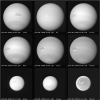Hazy Blue Worlds: A Holistic Aerosol Model for Uranus and Neptune, Including Dark Spots
- PMID: 35865671
- PMCID: PMC9286428
- DOI: 10.1029/2022JE007189
Hazy Blue Worlds: A Holistic Aerosol Model for Uranus and Neptune, Including Dark Spots
Abstract
We present a reanalysis (using the Minnaert limb-darkening approximation) of visible/near-infrared (0.3-2.5 μm) observations of Uranus and Neptune made by several instruments. We find a common model of the vertical aerosol distribution i.e., consistent with the observed reflectivity spectra of both planets, consisting of: (a) a deep aerosol layer with a base pressure >5-7 bar, assumed to be composed of a mixture of H2S ice and photochemical haze; (b) a layer of photochemical haze/ice, coincident with a layer of high static stability at the methane condensation level at 1-2 bar; and (c) an extended layer of photochemical haze, likely mostly of the same composition as the 1-2-bar layer, extending from this level up through to the stratosphere, where the photochemical haze particles are thought to be produced. For Neptune, we find that we also need to add a thin layer of micron-sized methane ice particles at ∼0.2 bar to explain the enhanced reflection at longer methane-absorbing wavelengths. We suggest that methane condensing onto the haze particles at the base of the 1-2-bar aerosol layer forms ice/haze particles that grow very quickly to large size and immediately "snow out" (as predicted by Carlson et al. (1988), https://doi.org/10.1175/1520-0469(1988)045<2066:CMOTGP>2.0.CO;2), re-evaporating at deeper levels to release their core haze particles to act as condensation nuclei for H2S ice formation. In addition, we find that the spectral characteristics of "dark spots", such as the Voyager-2/ISS Great Dark Spot and the HST/WFC3 NDS-2018, are well modelled by a darkening or possibly clearing of the deep aerosol layer only.
Keywords: Neptune; Uranus; aerosol structure.
© 2022. The Authors.
Figures























References
-
- Ackerman, A. S. , & Marley, M. S. (2001). Precipitating condensation clouds in substellar atmospheres. Acta Pathologica Japonica, 556(2), 872–884. 10.1086/321540 - DOI
-
- Asplund, M. , Grevesse, N. , Sauval, A. J. , & Scott, P. (2009). The chemical composition of the Sun. Annual review of astronomy and astrophysics, 47(1), 481–522. 10.1146/annurev.astro.46.060407.145222 - DOI
-
- Banfield, D. , Gierasch, P. J. , Bell, M. , Ustinov, E. , Ingersoll, A. P. , Vasavada, A. R. , et al. (1998). Jupiter’s cloud structure from Galileo imaging data. Icarus, 135(1), 230–250. 10.1006/icar.1998.5985 - DOI
-
- Barceló‐Llull, B. , Sangrà, P. , Pallàs‐Sanz, E. , Barton, E. D. , Estrada‐Allis, S. N. , Martínez‐Marrero, A. , et al. (2017). Anatomy of a subtropical intrathermocline eddy. Deep‐Sea Research Part I: Oceanographic Research, 124, 126–139. 10.1016/j.dsr.2017.03.012 - DOI
LinkOut - more resources
Full Text Sources
